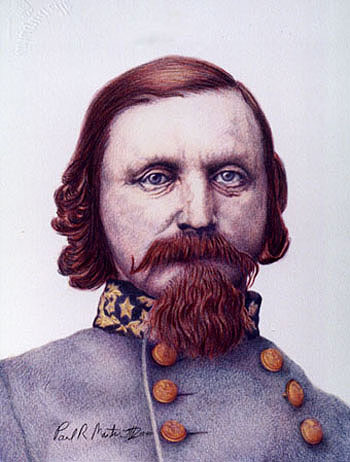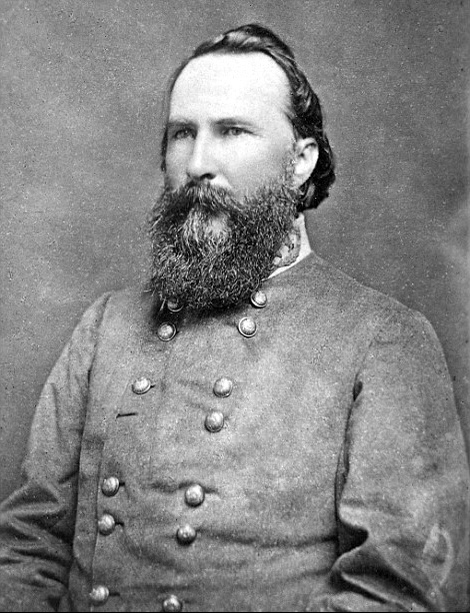

 Lieutenant James Longstreet
Lieutenant James Longstreet 

Mona’s artist statement
Pickett’s charge was a small, short battle that happened on July 3, 1863 at 3pm. The mini-battle lasted barely 50 minutes. Two generals, who were both on their way to battle at cemetery hill, when they crossed paths. It was mostly a spur-of the-moment charge.
On the bottom of the quilt square, are two brothers who were fighting on opposite sides. They are crying, because they have died. On top of them is many rocks, which represent the stress and pressures which soldiers have to endure. Mixed in with the rocks is a scale, which is measuring a way of life, versus slavery, which is represented by a slave’s fist. Also piled on top of the brothers, are guns and cannons, the objects that shaped our country.
This event teaches us many things:
1. Thinking before acting
If Pickett and his division did this, would the unionists have won the Gettysburg battle?
2. Control your emotions
Although violence is what shaped our country, would we be the same if we were always civil and peaceful?
3. Is what we’re doing worth it? Will this make a difference?
If we would have asked ourselves this, I think a lot less people would have died in this war, and in others. Maybe these brothers would have gotten a chance to chat and catch up.
Sydney’s artist statement
The battle of Pickett’s charge occurred on July 3rd, 1863, and lasted barely 50 minutes. The battle was a test of both physical and mental strength for the men who fought. It was an attempt to penetrate the union’s defense and center.
In the construction of this quilt piece, I realized that it was not just a battle; there was pressure on the men as they fought. Brother against brother is the symbolism of the two men on the bottom of the quilt piece. They were both brothers, but fighting for two different ways of life. The scale shows that on side has a way of life, and the other side has human rights. The outline of the United States represents how much rested on these men’s soldiers as they battled. One wrong move, and the whole future of the United States could change. A letter in the corner shows how much these men actually felt, and they had families and a home that they hoped to go back to someday.
The battle of Pickett’s charge changed the way we are today, because if the union had not stood up to the confederate attack, we would have most likely lost the battle of Gettysburg. The quilt piece shows us how much we should respect both parties because no matter how much stress and pressure the battle put upon them, they still held their ground, and tried their best.
Thank you for taking the time to learn about Pickett's Charge!
- Sydney and Mona, Frank's Design team
4 comments:
I think that it would be beneficial for you to review your history a bit. Pickett and Longstreet were both Confederate generals, and Pickett's charge was a failed Confederate attack upon the Union. Also, Longstreet was against the charge and correctly predicted its complete failure. Just thought you should know that your information isn't accurate.
Also, Pickett's charge was not some short, "spur the moment" battle. It was an all out attack by the Confederates upon the Union in which about half of the Confederate army present at the battle (tens of thousands of men) was wiped out, rather than just Picket’s division as you stated. I don't mean to be a stickler about this, but your information is grossly inaccurate. Please review your history and update your site, and in the future please be a bit more careful about what you post online, as this is how misinformation gets spread around. Thanks.
http://www.militaryhistoryonline.com/gettysburg/getty32.aspx
http://www.brotherswar.com/Gettysburg-3c.htm
http://en.wikipedia.org/wiki/Pickett%27s_charge
Hi there, came across this and loved the collection of images. BUT you do need to get the information right! Scott commented on this almost a year ago.
Post a Comment